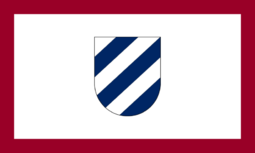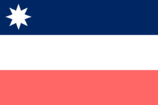Flag of Ostry: Difference between revisions
No edit summary |
No edit summary |
||
| Line 10: | Line 10: | ||
| Symbol = | | Symbol = | ||
| Proportion = 3:5 | | Proportion = 3:5 | ||
| Adoption = 20 | | Adoption = 20 January 1995 | ||
| Relinquished = | | Relinquished = | ||
| Design = White field with a red border and the [[Coat of arms of Ostry|coat of arms of Ostry]] in the centre. | | Design = White field with a red border and the [[Coat of arms of Ostry|coat of arms of Ostry]] in the centre. | ||
| Line 29: | Line 29: | ||
The '''flag of Ostry''' is a white field with a red border and the [[Coat of arms of Ostry|coat of arms of Ostry]] in the centre. | The '''flag of Ostry''' is a white field with a red border and the [[Coat of arms of Ostry|coat of arms of Ostry]] in the centre. | ||
The flag was adopted in | The flag was adopted in 1995 following the [[Gardrag Agreement]] and the creation of Ostry as a national territory of Navack. However, despite its official use by the government, a opposing tricolour of blue, white, and green with three stars in the hoist is more often seen on the island, and considered the ''de facto'' flag of Ostric culture and heritage. | ||
==History== | ==History== | ||
The first attested flag representing Ostry dates back to 1919, during the [[Navish Republican Revolution of 1921|Navish Revolution]]. During the formation of the nascent Ostric Republic in December of 1919, various flags using blue and white, taken from the coat of arms, were used interchangeably. The most popular in the first months was a tricolour of blue, white, and green with the phrase ''chléb ë wòlnosc'' ("bread and freedom") emblazoned on the white stripe in gold. By the collapse of the republic and re-absorption into Navack in 1921, a new design, excluding the motto and including three white stars on the hoist, was more commonly seen. Since then, this design was considered the ''de facto'' flag of Ostry and quickly adopted by separatists and nationalists. | The first attested flag representing Ostry dates back to 1919, during the [[Navish Republican Revolution of 1921|Navish Revolution]]. During the formation of the nascent Ostric Republic in December of 1919, various flags using blue and white, taken from the coat of arms, were used interchangeably. The most popular in the first months was a tricolour of blue, white, and green with the phrase ''chléb ë wòlnosc'' ("bread and freedom") emblazoned on the white stripe in gold. By the collapse of the republic and re-absorption into Navack in 1921, a new design, excluding the motto and including three white stars on the hoist, was more commonly seen. Since then, this design was considered the ''de facto'' flag of Ostry and quickly adopted by separatists and nationalists. | ||
Per the signing of the Gardrag Agreement in | Per the signing of the Gardrag Agreement in 1995, granting the island devolved powers and its own national territory, debate ranged over whether the tricolour should be officially adopted or a new design commissioned. Due to the tricolour's connection to the radical [[Ostric People's Party]] from the 1920s onwards, a "neutral" flag was created, consisting of a white field with a red border and the [[Coat of arms of Ostry|coat of arms of Ostry]] in the centre, a supposedly "non-partisan" design. The tricolour remains popular on the island however, and the official flag has garnered no lasting connection to most of the population. | ||
<gallery> | <gallery> | ||
File:Ostryflag.png|Varient flag used by the Ostric independence movement since 1919 | File:Ostryflag.png|Varient flag used by the Ostric independence movement since 1919 | ||
Revision as of 21:21, 20 August 2019
 | |
| Use | State flag and civil ensign |
|---|---|
| Proportion | 3:5 |
| Adopted | 20 January 1995 |
| Design | White field with a red border and the coat of arms of Ostry in the centre. |
 Variant flag of Ostry | |
| Name | Trzëfarwa (Tricolour) |
| Proportion | 2:3 |
| Design | A horizontal tricolour of blue, white, and green with three white stars on the upper hoist. |
The flag of Ostry is a white field with a red border and the coat of arms of Ostry in the centre.
The flag was adopted in 1995 following the Gardrag Agreement and the creation of Ostry as a national territory of Navack. However, despite its official use by the government, a opposing tricolour of blue, white, and green with three stars in the hoist is more often seen on the island, and considered the de facto flag of Ostric culture and heritage.
History
The first attested flag representing Ostry dates back to 1919, during the Navish Revolution. During the formation of the nascent Ostric Republic in December of 1919, various flags using blue and white, taken from the coat of arms, were used interchangeably. The most popular in the first months was a tricolour of blue, white, and green with the phrase chléb ë wòlnosc ("bread and freedom") emblazoned on the white stripe in gold. By the collapse of the republic and re-absorption into Navack in 1921, a new design, excluding the motto and including three white stars on the hoist, was more commonly seen. Since then, this design was considered the de facto flag of Ostry and quickly adopted by separatists and nationalists.
Per the signing of the Gardrag Agreement in 1995, granting the island devolved powers and its own national territory, debate ranged over whether the tricolour should be officially adopted or a new design commissioned. Due to the tricolour's connection to the radical Ostric People's Party from the 1920s onwards, a "neutral" flag was created, consisting of a white field with a red border and the coat of arms of Ostry in the centre, a supposedly "non-partisan" design. The tricolour remains popular on the island however, and the official flag has garnered no lasting connection to most of the population.
Proportions and colours
The official proportions of the flag is 3:5, with the coat of arms positioned in the centre. Despite the official proportions however, flags in the proportions of 2:3 and 1:2 are also widely used, especially in regards to the tricolour flag, which is only produced unofficially and not by any government agencies.
